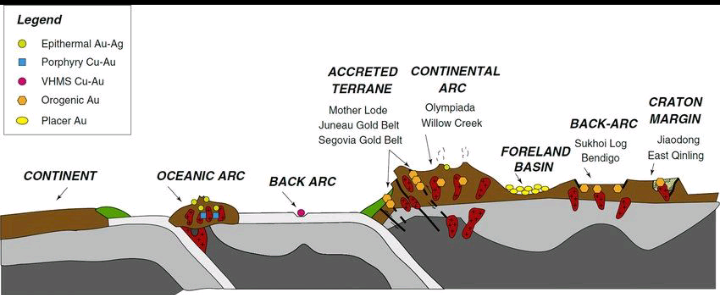Gold has been one of the most sought-after minerals for centuries due to its value and rarity. Prospectors, geologists, and even hobbyists often search for gold-bearing rocks in the field. But how do you identify rocks that contain gold? This guide will provide an in-depth look at the geological features, rock types, and mineral indicators that suggest the presence of gold.
1. Understanding the Geological Settings of Gold
Gold is commonly found in specific geological environments, including:
- Hydrothermal Vein Deposits – Gold is deposited by hot, mineral-rich fluids moving through cracks in the Earth’s crust. These veins are often associated with quartz.
- Placer Deposits – Gold eroded from primary sources and deposited in riverbeds or alluvial sediments.
- Greenstone Belts – Ancient, metamorphosed volcanic rocks where gold is commonly associated with sulfide minerals.
- Intrusive Igneous Rocks – Gold is sometimes associated with granitic and porphyritic rocks.
2. Key Rocks Associated with Gold

Certain rock types are more likely to contain gold than others. Here are the main gold-bearing rocks:
a) Quartz Veins
- One of the most common indicators of gold mineralization.
- Look for milky white, iron-stained, or glassy quartz veins cutting through host rocks.
- Gold is often found in fractures, cavities, or along the edges of quartz veins.
b) Iron-Stained Rocks (Gossan)
- Rust-colored (reddish-brown) rocks indicate oxidation of sulfides, often hinting at gold presence.
- Found in weathered outcrops of mineralized zones.
c) Greenstone & Schist
- Common in gold-rich regions like Canada, Australia, and Africa.
- Greenstone belts are ancient volcanic rocks altered by heat and pressure.
d) Porphyry Rocks
- Coarse-grained igneous rocks with large crystals.
- Some porphyry copper deposits contain gold as a byproduct.
e) Serpentine & Ultramafic Rocks
- Associated with lode gold deposits.
- Found in fault zones where gold has been remobilized.
3. Mineral Indicators of Gold Presence
a) Pyrite (“Fool’s Gold”)
- While pyrite itself doesn’t contain gold, its presence suggests hydrothermal activity, which could indicate nearby gold mineralization.
- Look for brassy, metallic crystals in quartz veins.
b) Chalcopyrite & Bornite
- Copper sulfide minerals that often coexist with gold.
- Found in hydrothermal veins and porphyry deposits.
c) Magnetite & Hematite
- Iron oxides commonly associated with gold deposits.
- Use a magnet to test for magnetite in suspected gold-bearing rocks.
d) Tellurides (Calaverite, Sylvanite, Petzite)
- Rare gold-bearing minerals that occur in high-grade deposits.
- Found in quartz veins with silver and other sulfides.
4. Field Identification Techniques
a) Visual Inspection
- Look for quartz veins, iron staining, or mineralized rock fragments.
- Check for visible gold (though rare, it can be seen in rich ore samples).
b) Hardness Test
- Gold is softer than most minerals (Mohs hardness of 2.5-3).
- It can be scratched with a copper coin but won’t be scratched by a knife.
c) Density Test
- Gold is very dense (19.3 g/cm³).
- Compare suspected gold to common look-alikes like pyrite (5 g/cm³) by weighing them in hand.
d) Streak Test
- Rub the mineral on an unglazed porcelain plate.
- Gold leaves a yellow streak, while pyrite leaves a black streak.
e) Acid Test
- Gold does not react to nitric acid, while pyrite and other sulfides fizz and dissolve.
f) Metal Detector & Panning
- A gold detector can help locate metal-rich veins.
- Pan sediments from nearby streams to test for gold flakes.
5. Where to Search for Gold-Bearing Rocks
a) Rivers & Streams (Placer Deposits)
- Check inside bends of rivers, behind large boulders, or in natural riffles where gold settles.
- Look for black sand deposits, which often indicate heavier minerals like gold.
b) Fault Zones & Contact Zones
- Areas where different rock types meet, especially near faults, can be gold-rich.
c) Historic Mining Districts
- Many old mines were abandoned with gold still in the rock.
- Research old geological reports and maps to find promising areas.
6. Common Mistakes to Avoid
- Mistaking Pyrite for Gold – Pyrite is brittle and shatters, while gold is malleable.
- Ignoring Sulfide Minerals – Sulfide-rich zones often contain fine gold.
- Overlooking Small Veins – Even thin quartz veins can hold gold.
- Not Checking Weathered Rocks – Surface oxidation can expose gold deposits.
7. Final Thoughts: The Importance of Laboratory Testing
While field identification methods are useful, the best way to confirm gold content is through laboratory testing, such as:
- Fire Assay – The most accurate method for determining gold concentration.
- X-ray Fluorescence (XRF) – A non-destructive technique for identifying gold content.
- Gravimetric Analysis – A precise way to measure gold in ore samples.
Conclusion
Identifying gold-bearing rocks in the field requires a combination of geological knowledge, mineral identification skills, and practical experience. By understanding the types of rocks and minerals associated with gold, using field techniques, and testing samples, you can increase your chances of finding gold in nature.
Would you like me to add specific examples of gold-bearing locations or tools for prospecting?
Leave a comment